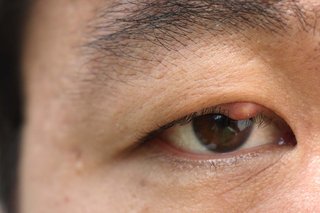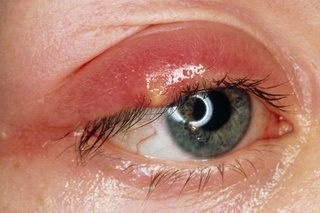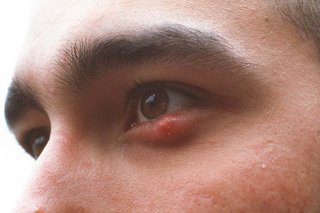Stye
Symptoms of a stye

Cn Boon / Alamy Stock Photo https://www.alamy.com/stock-photo-eye-stye-14783282.html?pv=1&stamp=2&imageid=9AEC8DFF-2B63-49E1-95E3-559FC938EDC2&p=14162&n=0&orientation=0&pn=1&searchtype=0&IsFromSearch=1&srch=foo%3dbar%26st%3d0%26pn%3d1%26ps%3d100%26sortby%3d3%26resultview%3dsortbyRelevant%26npgs%3d0%26qt%3dstye%26qt_raw%3dstye%26lic%3d3%26mr%3d0%26pr%3d0%26ot%3d0%26creative%3d%26ag%3d0%26hc%3d0%26pc%3d%26blackwhite%3d%26cutout%3d%26tbar%3d1%26et%3d0x000000000000000000000%26vp%3d0%26loc%3d0%26imgt%3d0%26dtfr%3d%26dtto%3d%26size%3d0xFF%26archive%3d1%26groupid%3d%26pseudoid%3d%26a%3d%26cdid%3d%26cdsrt%3d%26name%3d%26qn%3d%26apalib%3d%26apalic%3d%26lightbox%3d%26gname%3d%26gtype%3d%26xstx%3d0%26simid%3d%26saveQry%3d%26editorial%3d%26nu%3d%26t%3d%26edoptin%3d%26bespoke%3d4%26customgeoip%3dGB%26apaid%3d%7b18B189B6-6A83-41BD-8442-2448A6B7E281%7d%26custspecid%3d14369B5F-24B7-4344-B743-D5DE569A1F46%26cap%3d1%26cbstore%3d1%26vd%3d0%26lb%3d%26fi%3d2%26edrf%3d0%26ispremium%3d1%26flip%3d0%26pl%3d

WESTERN OPHTHALMIC HOSPITAL/SCIENCE PHOTO LIBRARY https://www.sciencephoto.com/media/252333/view

FRANCOISE SAUZE/SCIENCE PHOTO LIBRARY https://www.sciencephoto.com/media/252669/view
A stye usually only affects 1 eye, but it's possible to have more than 1 at a time and on both eyes.
It's probably not a stye if:
- there's no lump – if your eye or eyelid is swollen, red and watery it's more likely to be conjunctivitis or blepharitis
- the lump is hard but not very painful – this is more likely to be a chalazion
Find out more about chalazions on the Moorfields Eye Hospital website
How you can treat a stye yourself
To reduce swelling and help the stye heal:
- Soak a clean flannel in warm water.
- Hold it against your eye for 5 to 10 minutes.
- Repeat this 2 to 4 times a day.
To relieve the pain, take painkillers such as paracetamol or ibuprofen. Do not give aspirin to children under 16.
Avoid wearing contact lenses and eye make-up until the stye has burst and healed.
Important: Do not burst a stye
Do not try to burst a stye or remove an eyelash yourself. This can spread the infection.
Non-urgent advice: See a GP if:
- a stye does not get better within a few weeks
Urgent advice: Ask for an urgent GP appointment or get help from NHS 111 if:
- a stye is very painful or swollen
- it affects your vision
- your eye is producing pus
- the infection has spread to your eye or eyelid
You can call 111 or get help from 111 online.
Treatment from a GP
If you have a stye, the GP may:
- burst the stye with a thin, sterilised needle
- remove the eyelash closest to the stye
- refer you to an eye specialist in hospital
How to prevent a stye
You can help avoid stye by keeping your eyes clean.
Styes are often caused by bacteria infecting an eyelash follicle or eyelid gland.
You're also more likely to get a stye if you have long-term blepharitis or rosacea.
Do
-
wash your face and remove eye make-up before bed
-
keep your eyelids and eyelashes clean, especially if you have blepharitis
-
wash your hands before putting contact lenses in or taking them out
Don’t
-
do not share towels or flannels with someone who has a stye
-
do not rub your eyes if you have not recently washed your hands
Page last reviewed: 18 April 2024
Next review due: 18 April 2027